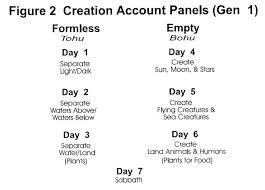Richard, I think your comment about NIV shows that, even if we avoid the contradictory scholars, the translators don’t, and are bound to slant their word-choices according to what side they come down on. “Vault” is one such extrapolation from a word that, whatever it means, never means that. One general observation is that translators are likely to be more influenced by biblical scholars than by Assyriologists, and there are particular “fashions” in both camps.
In the end we all have to make our choices, and it’s clearly better to do it from as many translations as possible than from one. Unless we just learn Hebrew…
I’m very happy to agree with you that the raqia is the sky. Personally I see good reasons for thinking the writer meant no more or less than that, even to the point of being as flexible as we are in the particular way he uses it at different times: today I flew a kite in the sky, even though when I look at stars in the night sky I have an entirely different thing in mind.
I’ll make no comment on our disagreement on how much water is up there, except to note an interesting point by Poythress (in a different paper, I think!) that Gen 1 is concerned to deal with phenomena that matter to his readers: and it completely fails to deal with clouds or rain, which matter a great deal more than a theoretical cosmic ocean would… unless the firmament is about clouds and rain (I should add that there are numerous biblical references to rain coming from clouds).
I’m interested in your attribution of the light on Day 1 to sunlight, because it seems to commit you to some kind of belief (as far as the story goes) that the sun was there from the start rather than being actually created on Day 4, but hidden from view in some way.
A lot of commentators taking the “framework” position use the light-before-the-sun idea for some kind of spiritual lesson, eg that God can make light even without the sun if he wants, or that v3 refers to the everlasting light surrounding God. That seems spurious to me, though I’m happy to agree with the “framework” idea that day is created on Day 1, and the sun to rule/populate it in Day 4, as far as its literary purpose goes.
But when I read that the early pre-philosophical Greeks based their word for the upper air on the word “light”, I remembered my childhood mystification at being told that the sun makes the sky light blue, when intuitively (like the moon) it shines on its own.
It seems to me that phenomenologically there is no necessary link between the sun and daylight, which would of course make the Gen 1 account, if it separated the two, just as erroneous scientifically as it would by positing a solid raqia. But that is only significant if the account were “ancient science”, and I don’t believe it is. Phenomenologically speaking, it would be stating what is observed, without any theory (but with the theological lessons of the poetic framework, which are still of value).
That brings me to your point about my time and energy. It’s certainly true that I see pitfalls in the attribution of scientific error to Scripture, as outlined in detail by Poythress. Peter Enns is an example - it’s not long before he extends the scientific fallibility of Scripture to theological fallibility, built on the same theory of “incarnational inspiration”.
But at least as much as that is the conviction of the scientist (or medic) in me that says that faulty understandings tend to end in faulty conclusions: truth tends to resolve apparent conflicts simply. I simply found that once I read the relevant texts in the Scriptures carefully I could find neither a cosmic ocean, nor a solid firmament, and that the texts made much more sense without them. It’s the same kind of motivation that would make me argue against the Creationists’ “vapour canopy” if any of them still believed in it, and that makes me argue against the concept of a “fallen creation” on the same grounds.

